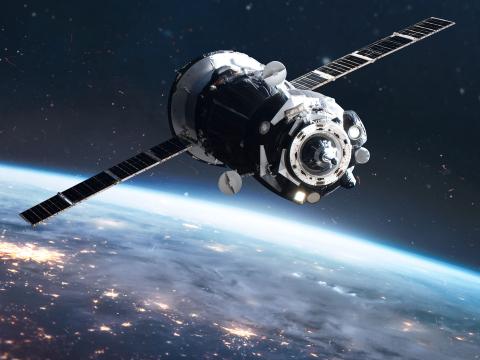Quantum Communications: Replacing the Slow Speed of Light
In December, my monthly blog was an article titled Quantum, Artificial Intelligence, Dilbert and Duct Tape. Quantum interests me. "Dilbert" I read daily, and duct tape saved the protagonist in Andy Weir’s novel "The Martian." It’s not that I understand basic principles of quantum mechanics, but there is so much that quantum mechanics and its associated physics offer that crosses so many technological fields and means for the future of space exploration.
Quantum mechanics can resolve the issue of time lag in command, control and communications (C3) with a side benefit—not addressed in this blog—of freeing up additional radio frequency (RF) spectrum within the growing world of wireless. Here, we'll talk instead about “entanglement.”
Entanglement is what Albert Einstein referred to as “spooky action at a distance.” Entangled quantum particles also are known to create a “teleportation” effect. Entangled quantum particles remain instant twin replicates of each other, regardless of the distance between them. When an action on one is changed, it results in an instantaneous similar action on the other. Such is the entanglement between the two particles that they remain a constant twin, regardless of distance.
Research explores how the quantum mechanics of entanglement can be a source for instantaneous communications. Understanding the principle of entanglement is important. It occurs when a pair of quantum particles physically interacts with each other, either serendipitously or intentionally, or when a single quantum particle such as photon is split. Scientists have used a laser beam to split single photons. Once split, the now two new photons exhibit the same properties. And, somehow they are linked—entangled—with each other so that whatever effect occurs on one also occurs on the other, regardless of how how far apart they are from each other.
Did you watch the Juno spacecraft activities on July 4th? I did. It was quite an achievement for our colleagues at NASA. Communications between the Juno spacecraft and NASA control was limited to the speed of light.
Quantum entanglement is not limited to the speed of light. Some scientists project that this instantaneous transfer of state between the two entangled elements takes place at approximately 10,000 times the speed of light, again, regardless of distance. The counter argument is that it is instantaneous, which means I repeat myself.
The communications time lag between the Juno spacecraft and NASA occurred because of the distance between the probe in the vicinity of Jupiter and Earth. The spacecraft had to approach on auto-pilot with humans on Earth crossing their fingers and rubbing a rabbit’s foot. Everything for those critical approaching miles on this historic, 1.8 billion-mile journey was programmed nearly five years earlier in computer programs onboard the Juno spacecraft. Even with communications traveling at the speed of light, it took 48 minutes for messages to travel between the spacecraft and NASA.
Within the concept of quantum communications, the transmission would have been instantaneous. Quantum communications would allow for instant software updates; enable human command and control whenever necessary; promote the ability to react immediately to any event; and even warn ahead of a solar event traveling behind the quantum communication at the slower speed of light.
Quantum communications, using the principle of entanglement, will bring a significant step forward in mankind’s venture across the universe. The entanglement principles that make quantum the optimum communications network for conquering space also are tied to the theory of teleporting.
Star Trek's “beam me up, Scotty” dialogue might not be as far out into the future as some of those born today may find.
David E. Meadows is a retired U.S. Navy captain and the author of the Sixth Fleet series, along with Seawolf, Joint Task Force Liberia, Tomcat, Final Run and other action-adventure novels. He currently is working on a nonfiction effort titled Red Crown, Charger Horse and the Cryptologic Tide.





Comment
No-communication theorem
Thanks for the interesting post David. Got me thinking and reading further, which led me to the No-communication theorem which states that using the entanglement to convey information by either controlling or measuring any one of the particles is not possible. I'm curious as to whether you've come across research that overcomes this impossibility.
No Communications Theorem
@Victor
Without preempting in any way what David might say... I "think" David means a quantum teleportation protocol. You can't use a quantum entanglement protocol to "transmit" quantum entangled information alone as in a "message". In quantum teleportation protocols, an entangled state may be used to distribute "classical information" imperfectly, via a single spatially shared entangled state, which does not require that state to be collapsed. Of course "imperfection" occurs with most forms of communication and we must have error correcting codes or redundancy to handle any of that. These technologies are still in their infancy. See "Some Comments" in Wikipedia on "No-communication theorem" - https://en. wikipedia. org/wiki/No-communication_theorem#Some_comments.
Wikipedia "Some comments" says: "this article assumes that the quantum system shared by Alice and Bob is a composite system, i.e. that its underlying Hilbert space is a tensor product whose first factor describes the part of the system that Alice can interact with and whose second factor describes the part of the system that Bob can interact with." All that being stated, it "IS" possible to relay remote information using "Spooky Action at a Distance".
Entanglement exists in all parts of a single distributed entangled state, such as a pair of entangled photons, and each might be "stored" in a quantum buffer, a atom state or other quantum object, at either end. Separable aspects in more than one property of the quantum state would allow more information to be sent than just one bit. The basic entanglement of the Qubit is "sacrosanct" though. The distribution would be via "orthogonal semi-classical" aspects of the quantum state which are still "information" even if we are only speaking about the "outline" of a packet or some spin or perhaps polarization properties of the state in it's globally distributed spatial elements. These complementary properties do not share the inseparability of the "pure" entangled state.
It would be an excellent way to communicate directly to the surface of Mars via "VR Telepresence" using a humanoid robot without endangering human lives and performing exploration and building habitats etc. Could be made to be just like being there in person. The physics is still a very long way from accomplishing that end of course. The concept of "Faster-than-Light" communication is not involved here. It is all about the shared properties of a single quantum state that is "space-like separated".
There may be some limitations in range though which will remain unknown unless they are tested. For example a "Quantum Radar" System, recently discussed in the news, being currently tested by a number of Governments has a range of 100 km, is potentially able to determine the outline and partial properties of distant targets, invisible to normal types of radar, which rely on the back scattering of photons. Stealthy aircraft produce a signature about the size of a golf ball at two kilometers. Still... that is "something". Quantum Radar might only rely on the absorption of a "few" entangled photons, a process in which a stealthy plane tries to optimize, and by the weak monitoring of a twin photon held in buffers at the transmission facility, able to betray the properties of a distant plane even if it were using a form of stealth technology. Because entanglement is used, no amount of jamming would be able to assist in hiding this "passive" signature.
Comments